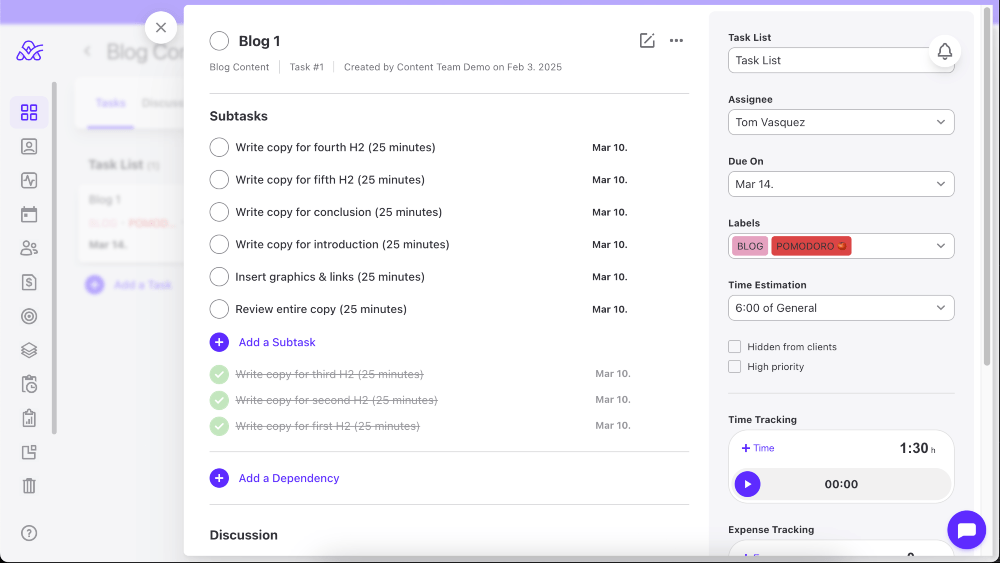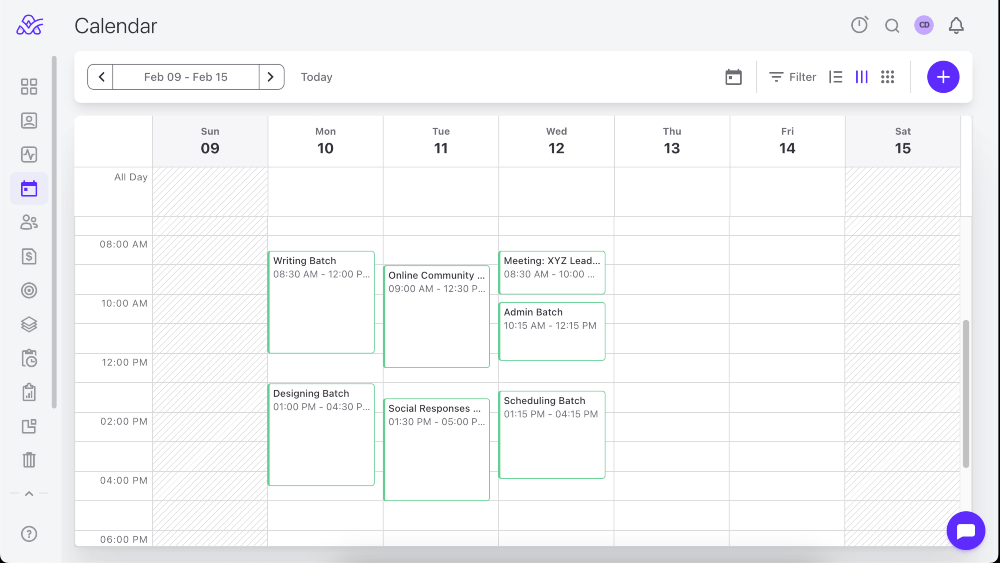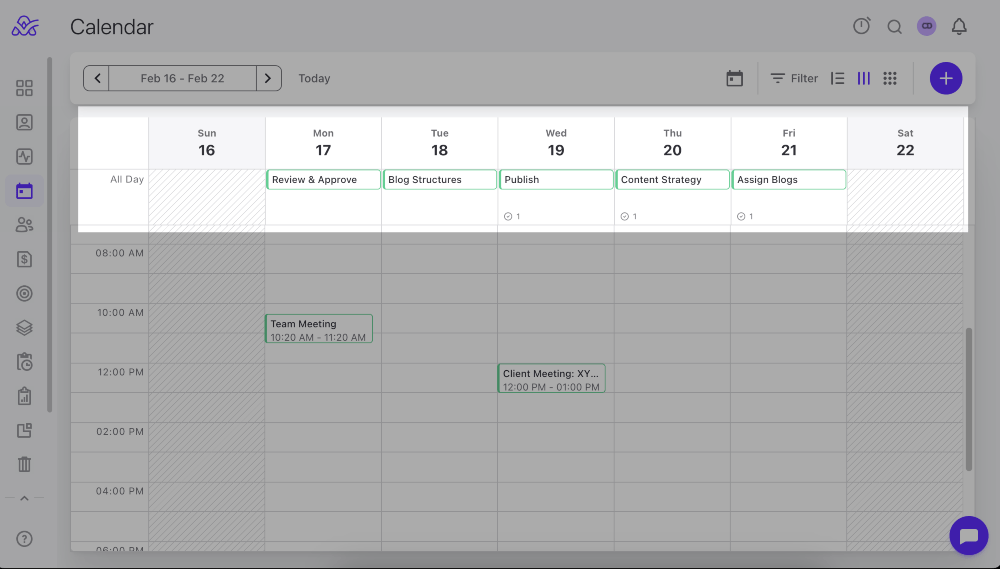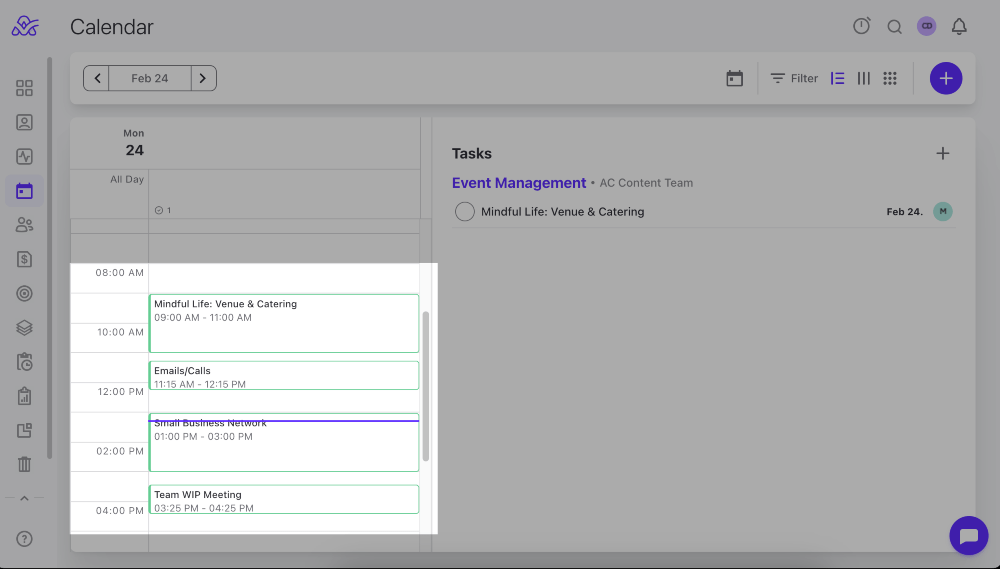Just because you’re working long hours doesn’t mean you’re being productive. In fact, according to Business News Daily, research has found that overtime is the one thing that’s likely to lead to lower levels of productivity.
So, what increases productivity, then? We did a bit of reading, and we’ve found a couple of things. The first is monotasking (the opposite of multitasking), the second is minimal distractions (no surprise there), and the third is taking regular breaks.
That all sounds simple enough, but how do you go about applying all three? We’ve got two words for you: time blocking. It’s a fail-proof strategy that’s been around for decades and guarantees better time management, efficiency, and work output of a higher quality. That got your attention, didn’t it? Keep reading to find out what time blocking is, how it works, and how you can apply it to your working day!
What Is Time Blocking?
Time blocking is a productivity and time management technique that helps promote deep work, minimizes procrastination, and creates order in your day. The idea behind it is to divide your working day, or week, into blocks of time dedicated to particular tasks.
It’s a hack that can be applied in four different ways (methods) and can work wonders for your creative output. That is when you select the right method, for your working style, and align it to the type of tasks you need to deliver.
How To Apply Time Blocking
Before you go and jump into time blocking, there are a few pre-steps you’ll need to take to set yourself up for success and maximize your work efficiency potential.
1. Prioritize Your Tasks

The first step is to prioritize the tasks on your to-do list.
This is all about identifying and listing the order in which your tasks need to be completed, based on their importance, and the impact they deliver to the business.
There are several techniques you can use to prioritize your tasks like a pro. From the super simple Eat The Frog and the Get Things Done (GTD) methods, to more complex ones like ABCDE, MoSCoW, and Eisenhower Matrix, you can take your pick to pinpoint the work that demands and deserves your attention first.
To give yourself a visual representation of all your tasks and their level of priority, you can use a work management tool like ActiveCollab to set up a birds-eye-view of your entire to-do list which lets you:
- Create and monitor tasks (so you have a high-level overview of all work on your radar)
- Set multiple customizable labels that reflect priority or the type of work ( so you see the stage each task is at and quickly spot impending tasks)
- Allocate timelines and deadlines for task completion (so you stay on top of due dates)
- Track the time it takes to complete each task (so you can make better estimates for future time blocks)

2. Work Out Your Most Productive Time
Now, you might think this second step is trivial, but the time of day you choose to do certain tasks can have a huge impact on your productivity, and the quality of your output.
We’re all different. Some of us are early-bird-gets-the-worm types, others are fiery night owls who focus better during the quiet hours when the whole world is asleep.
So when you have your to-do list ready in order of priority, it’s time to do a bit of self-analysis. You can do this over a one-week period where you monitor and record your insights.
Throughout that week, ask yourself:
- When do I enjoy working most?
- When am I most alert and attentive?
- When am I least focused and enthusiastic about work?
- When are my highs and lows in terms of energy and cognition?
- When do I deliver my best work?
The aim of this exercise is to capitalize on your circadian rhythm. What’s that again? It’s the biological process that dictates your energy levels, concentration, and mood.
When you identify where, and when your high and low energy levels are, you can match your work accordingly. So you schedule priority and difficult tasks to be completed during your peak productivity hours, and the ad-hoc administrative-type tasks during the sloping ditch hours.
3. Estimate Time Needed For Each Task
Step three is to estimate, as accurately as you can, the amount of time you need to complete each task.
This is a vital part of effective time blocking. It’s the one thing that either makes or breaks the entire concept. When you underestimate the time you need to complete a task, it could lead to a backlog of incomplete or late tasks which result in frustration, increased stress and possibly push you to give up on the method altogether.
So how do you make the best time guesstimate? There are a couple of ways you can go about it:
- First-time tasks – Guess the time it will take and double it. As humans, we tend to underestimate the amount of time we need to get things done. By giving yourself extra time, you prevent setting yourself up for failure. If you finish earlier, not only will you feel good and more enthusiastic about your next task, but you’ll also have extra time in your day to allocate to start something else earlier.
- Tasks you do regularly – Your guesstimate for tasks you do regularly will be more accurate and you’ll feel more confident about the time you block out. However, the same task for two different clients or projects may take different amounts of time. So take the average of the two variations. For example, add the times it took you to complete a particular task for two clients, then divide it by two.
- Use a time-tracker – The best way to estimate task time duration is to use a time-tracking tool like the one we have on ActiveCollab. You simply start your timer the minute you begin a new task, pause when you take breaks, restart when you get back onto it, and log a finish when the task is completed. If you do this for all your tasks, at the end of the week, or month, you can create reports to view and analyze how much time you spent doing what. This is a priceless productivity feature that helps service agencies not only bill clients for hours of service but also manage and plan their people and resource capacity.

Remember also that it may take some time before you fine-tune and get into the flow of your time-blocking system. Don’t expect to get every estimate right the first time around. Give yourself permission to be flexible in the first few weeks. The other thing you can do is make it a habit to insert a 30-minute or hour block of miscellaneous time in your diary to make up for any miscalculations or urgent and unplanned tasks that pop up out of the blue.
4. Choose The Best Method For Each Task
The last step is to select your time-blocking method, create the task blocks in your calendar, and hold yourself accountable to all your blocking promises.
Now don’t think you need to stick to one method for your entire day or week. You are free to mix and match as you like, or as your work style or task type dictates. Some tasks will work better in some methods than others.
But how do you know which one to choose? Try to make your decision based on:
- Task or work type – Some tasks require deep focus and several hours or days to complete. Examples of these might be developing an annual or quarterly content marketing strategy, or writing a 3000-word blog. These tasks are probably not a good fit for task batching or timeboxing. However, they are perfect for the Pomodoro Technique and day theming. On the other hand, the opposite is true for tasks like creating memes, writing short social media captions or responding to emails. They are an ideal fit for task batching and timeboxing because there’s not as much thinking and brainstorming involved, and they generally have short completion times.
- Personal preference – Some people like to switch up and do several different things in a day. Others prefer to stick to one thing and finish on the day. So a big part of making the right choice in time blocking methods will depend on your personal preference and working style. You might never apply one method but use the other three religiously. As long as you are reaping the productivity benefits of time blocking, it doesn’t matter how many different methods you apply.
Also, while you may be quite clear on the methods you do and don’t like, it’s a good idea to keep an open mind. It might be well worth your while to do a bit of trial and error where you test the four methods across four weeks for certain tasks to see which proves to be the most effective.
4 Time Blocking Methods
To explain each of the four time-blocking methods, we’ll go through each one in detail, but we’ll also showcase how each one might be used by real-life professionals.
Pomodoro Technique
The Pomodoro Technique involves breaking down one task into 25-minute intervals of focused work, with 5-minute breaks between each. After four intervals (two hours), you give yourself a 15-30-minute break. Ideally, you should use a timer to track your time so you stick exactly to the schedule.
The benefits of the Pomodoro method are:
- Feel less overwhelmed – When you have a large or complex task, it’s much easier to tackle when you divide and conquer in bite-sized chunks.
- Slash distractions – If you use a timer, chances are you’ll diminish the chance of being distracted by external forces. You know you want to make the best use of the small segment of time you have so you stay laser-focused throughout.
- Do-away with burnout – Because you take regular breaks, it’s highly unlikely you’ll experience burnout, which happens when you dedicate long periods to intense work without stopping to recharge.
Tom is an SEO Content Writer at a marketing agency who needs to deliver three blog posts each week, by Friday. To make the best use of his time, he uses the Pomodoro technique and divides each blog into 25-minute writing segments.
This is Tom’s blog task in ActiveCollab. Notice how he has created sub-tasks of 25 minutes for the larger task of producing an entire blog. As he finishes each subtask, he marks it off, takes a short break and moves on to the next one. Tom can also use the time tracking feature within this task to gather data (for future planning) on how long an average blog takes to complete.

Task Batching
Task batching is a method where you group and action similar or small tasks into one slot in your calendar. There are no rules around how long each slot should be, this is something you determine based on how much time you have in your calendar to accommodate the various tasks.
The benefits of using the task batching method are:
- Minimal context switching – Jumping to and from different tasks can make you lose productivity and focus. Every time you move to a new task, your brain needs time to get your head around it. When you group similar tasks, you focus and zone into the work at hand alone.
- Time-saving – When you alternate between tasks in a short period, you not only lose precious focus time, but you also lose actual time because switching platforms and documents minimizes efficiency.
- Combine and conquer – If your job is the kind that is made up of lots of different smaller tasks, the batching method helps you combine and conquer them in one sprinting go. This is sort of the opposite of the Pomodoro method where you aim to divide a task, and then conquer it.
Amy is a Social Media Manager at the same agency where Tom works. She needs to write, create, and post approximately 30 social media posts for a mix of clients each week. To make the best use of her time, she uses the task batching method to group her work into task types. This is what her calendar schedule looks like:

You’ll notice the way Amy batches her tasks is by work type rather than clients. She combines all her writing, designing and posting work into segments, rather than working on one client account at a time. She does this because she feels it’s the most efficient way to get things done with focus.
Day Theming
Day theming is blocking out your entire day to one task, client or project. It’s like an extreme form of task batching where you group your work by day. It’s ideal for people who like to get deep into a topic and work exclusively on one thing at a time, for an extended period.
The benefits of the day theming method are:
- Task immersion – Few time management techniques promote the kind of task immersion the way day-theming does. Because you know your entire working day will be allocated to one task or project, all your energy and thoughts will be directed solely towards the task which will get your absolute, undivided attention.
- No time slots to follow – Because your task is an all-day task, you don’t need to keep checking your calendar or schedule to see how much time you have before the next task. For some people, this removes the pressure of fitting their work into restrictive timeframes.
Vernon is a Content Manager & Strategist at a boutique SEO agency. Each week, he needs to send his entire team of writers their blog topics, review blog structures and drafts, and keep on top of all the published posts’ performance.
On top of that, he also has to develop the content strategy and stay across industry changes and organic SEO trends. He loves to use the day theming method to organize his week because it gives him the time, and space, to think and work with deep focus.
This is what Vernon’s calendar looks like:

ActiveCollab’s all-day event entry is the best way to apply day theming to your calendar. For each day, you see the task theme you have assigned, while leaving the entire calendar free so you can easily keep track of meetings.
This may not be a method for everyone, but it’s a valuable one to turn to when you need to dedicate yourself to an important piece of work.
Timeboxing
Timeboxing is when you allocate and block out a set amount of time for a particular task. By doing this, you promote full concentration and minimize distractions within that time slot. It’s a good method for managing deadlines, perfectionism and procrastination.
The benefits of the timeboxing method are:
- Increased productivity – A good percentage of humans are a funny lot who work better under pressure. This technique can work wonders for this lot of people because it forces them to produce work in a short, set time frame.
- Flexibility – The other great thing about timeboxing is that you choose how short or long your time boxes will be for each task. Unlike the Pomodoro method, it’s a flexible time-blocking option.
- Suitability for long task lists – If you’re under the pump and are going through a particularly busy time at work where you don’t know where to start, timeboxing can help you gradually get to everything, one timebox at a time. Instead of dedicating full days to each task, break your day down to work items that may be of equal priority, so you know both are tracking to completion.
Maria is an Event Manager at an events company. She is responsible for two key accounts. Each week she has to tick off a dozen or so different tasks for the two clients. This can be a nightmare when both have large events taking place in the same week.
To make the best use of her time, and to make sure she doesn’t let one of her client account’s work slip under the radar, she timeblocks equal amounts of time for each client every day.
This is what her calendar for a particular day looks like:

In Maria’s case, her calendar is set up in timeboxes of up to two hour timeslots for each client or task. The timeboxing method, while it can be restrictive, can also prove to be highly effective when you have a goal-oriented task that delivers a concrete output.
Ideally, time-boxing should work like the Pomodoro technique in the sense that you should be sticking to, and respecting the allocated time. However, you can give yourself some buffer room and go a little over time if you can see you are almost finished.
How Time Blocking Increases Productivity
No matter which time-blocking approach you take, you can be sure you’ll end up with a daily structure that organizes your working hours for optimal productivity.
Now, there are four things you can expect to experience when you apply some of the time-blocking methods we talk about.
Deep Work
Most time blocking methods (when applied correctly), stimulate deep work. This is a cognitive state where your concentration is at its highest level. When you enter a zone of deep work, you quite literally, use every ounce of brain power you have to give.
According to Forbes, for years, multitasking was thought to be the ultimate productivity hack. However, science tells a different story. A story where monotasking is king.
Focusing on one task at a time lets you devote all your energy, and achieve a level of creative flow that is unparalleled to the one you get while multitasking.
Minimal Distractions
One of the key aims of time blocking is to minimize and preferably eliminate distractions. When you get distracted, you end up spending more time on a task than you would have otherwise.
But how bad can this really be? Well, according to a small study from the University of California, Irvine, pretty bad.
Every time a worker is distracted or interrupted, it takes an average of 25 minutes to return to the task they were working on.
Now imagine being interrupted several times in the day. That’s a whole of hours gone to waste.
Organization & Order
Time blocking is not just a productivity hack. It’s also a helpful tool you can use to organize and structure your day. Imagine you come to work without a plan of attack for your to-do list. You have eight or so hours of productive work time, the first of which you spend trying to work out what you’ll work on.
According to HBR, when you use a time-blocking method like timeboxing, not only do you remove the daily decision drama of what to work on first, but you are also pushed to prioritize and organize your work day.
Making this kind of pre-planning a habit will let you achieve long-term productivity.
Control Perfectionism & Procrastination
When you assign a timeframe to a task, you increase your chance of completing it on time. Perfectionists and procrastinators know this all too well. That’s why they deliver when under pressure: because they have to.
But don’t take our word for it. Take it from Tim Urban who knows a thing or two about why procrastinators procrastinate.
So if you want to imitate the looming deadline Urban talks about that will push you to the finish line, you can turn to time blocking. It’s one of the best ways to manage procrastination and help you come to terms with unrealistic (perfectionistic) standards.
Use ActiveCollab To Block Time & Up Your Productivity
If you are looking to lift your game in terms of output and efficiency, time blocking is a technique that will do wonders for productivity. By applying one of the four methods, you’ll organize your workload in a way that lets you meet deadlines, and produce work worthy of praise.
As a workflow management platform, ActiveCollab comes with all the features professional service providers seek in one centralized tool to manage their time better and keep on top of deliverables.
From task and to-do list calendar scheduling to time tracking and team and client collaboration, the platform lets you manage and monitor entire workflows in real time, all the time.
With visual representations of all your work in progress, and upcoming projects and initiatives, you won’t need to switch back and forth between different apps and tools to meet your team’s and client's needs.
When choosing a tool to manage your client work, it pays to sign up for one that has been specially designed for your business model and type. ActiveCollab has been made with agency, consultancy and startup businesses’ needs in mind.
So, if you’re looking to streamline and improve the way you manage your service agency’s precious time, why not try ActiveCollab? Sign up for our 14-day free trial or book a demo to get a guided tour of the entire platform from one of our super-friendly team members!
